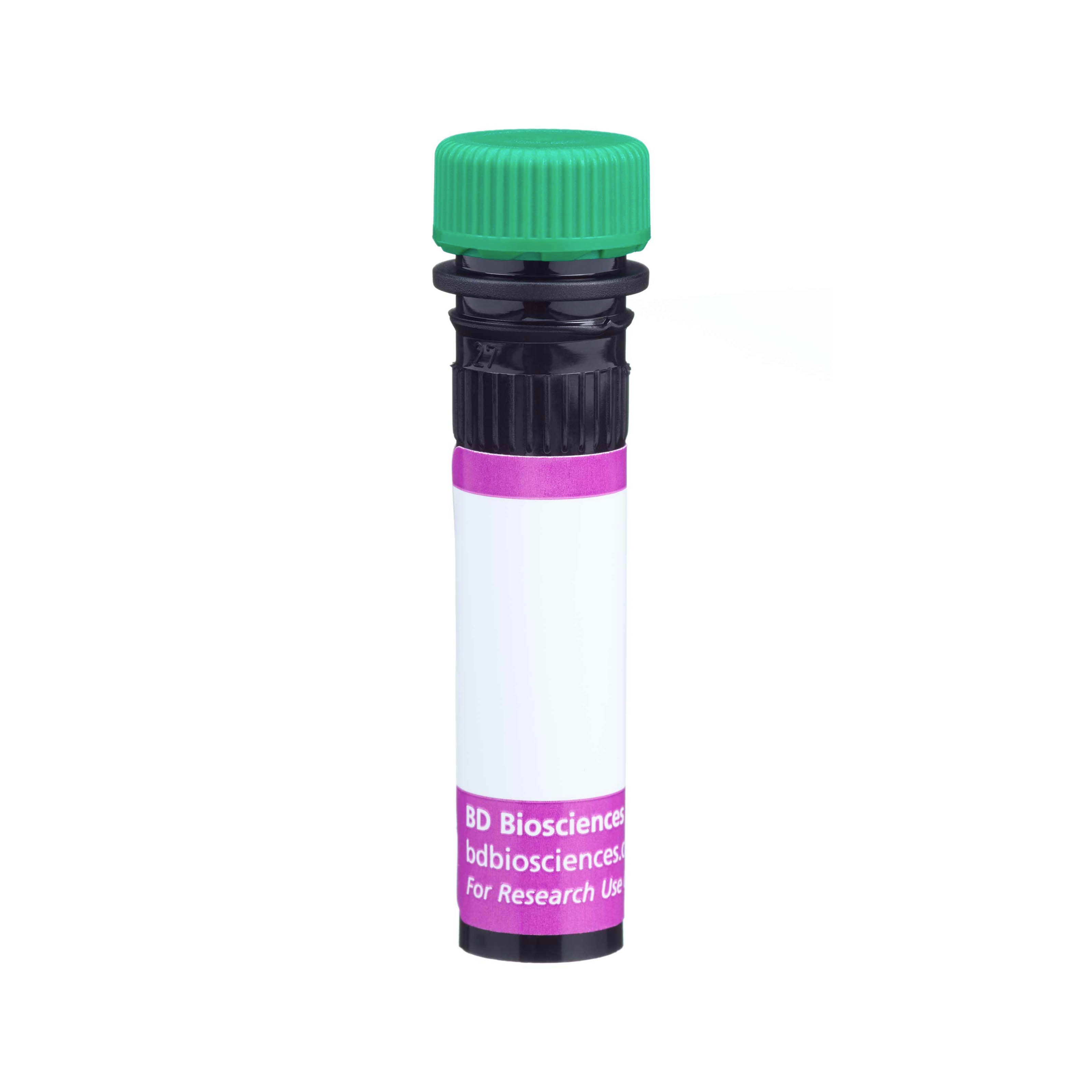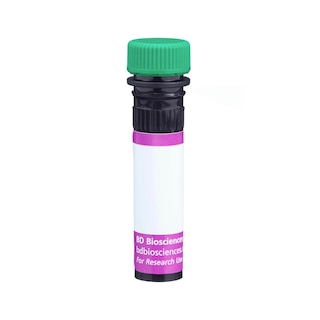Old Browser
This page has been recently translated and is available in French now.
Looks like you're visiting us from {countryName}.
Would you like to stay on the current country site or be switched to your country?
BD Horizon™ BV510 Mouse Anti-Human CD34
Clone QBEND/10.rMAb (also known as QB-END-10, QBEND10, QBEND/10, QBEnd10)
(RUO)



Multicolor flow cytometric analysis of CD34 expression on Human peripheral blood mononuclear cells. Human peripheral blood mononuclear cells (PBMC) were preincubated in the presence of Human BD Fc Block™ (Cat. No. 564219/564220). The cells were then stained with PE-Cy7 Mouse Anti-Human CD14 (Cat. No. 557742/560919), PE Mouse Anti-Human CD133 (Cat. No. 566593/566594) antibodies, and with either BD Horizon™ BV510 Mouse IgG1, κ Isotype Control (Cat. No. 562946; Left Plot) or BD Horizon™ BV510 Mouse Anti-Human CD34 antibody (Cat No. 569026/569027; Right Plot). BD Via-Probe™ Cell Viability 7-AAD Solution (Cat. No. 555815/555816) was added to cells right before analysis. The pseudocolor density plot showing the correlated expression of CD34 (or Ig Isotype control staining) versus CD133 was derived from CD14-negative gated events with the forward and side light-scatter characteristics of viable (7-AAD-negative) lymphocytes. Flow cytometry and data analysis were performed using a BD LSRFortessa™ X-20 Cell Analyzer System and FlowJo™ software.


BD Horizon™ BV510 Mouse Anti-Human CD34

Regulatory Status Legend
Any use of products other than the permitted use without the express written authorization of Becton, Dickinson and Company is strictly prohibited.
Preparation And Storage
Recommended Assay Procedures
BD® CompBeads can be used as surrogates to assess fluorescence spillover (Compensation). When fluorochrome conjugated antibodies are bound to BD® CompBeads, they have spectral properties very similar to cells. However, for some fluorochromes there can be small differences in spectral emissions compared to cells, resulting in spillover values that differ when compared to biological controls. It is strongly recommended that when using a reagent for the first time, users compare the spillover on cells and BD® CompBeads to ensure that BD® CompBeads are appropriate for your specific cellular application.
For optimal and reproducible results, BD Horizon Brilliant™ Stain Buffer should be used anytime BD Horizon Brilliant™ dyes are used in a multicolor flow cytometry panel. Fluorescent dye interactions may cause staining artifacts which may affect data interpretation. The BD Horizon Brilliant™ Stain Buffer was designed to minimize these interactions. When BD Horizon Brilliant™ Stain Buffer is used in the multicolor panel, it should also be used in the corresponding compensation controls for all dyes to achieve the most accurate compensation. For the most accurate compensation, compensation controls created with either cells or beads should be exposed to BD Horizon Brilliant™ Stain Buffer for the same length of time as the corresponding multicolor panel. More information can be found in the Technical Data Sheet of the BD Horizon Brilliant™ Stain Buffer (Cat. No. 563794/566349) or the BD Horizon Brilliant™ Stain Buffer Plus (Cat. No. 566385).
Product Notices
- Please refer to www.bdbiosciences.com/us/s/resources for technical protocols.
- This reagent has been pre-diluted for use at the recommended Volume per Test. We typically use 1 × 10^6 cells in a 100-µl experimental sample (a test).
- An isotype control should be used at the same concentration as the antibody of interest.
- Caution: Sodium azide yields highly toxic hydrazoic acid under acidic conditions. Dilute azide compounds in running water before discarding to avoid accumulation of potentially explosive deposits in plumbing.
- For fluorochrome spectra and suitable instrument settings, please refer to our Multicolor Flow Cytometry web page at www.bdbiosciences.com/colors.
- BD Horizon Brilliant Violet 510 is covered by one or more of the following US patents: 8,575,303; 8,354,239.
- BD Horizon Brilliant Stain Buffer is covered by one or more of the following US patents: 8,110,673; 8,158,444; 8,575,303; 8,354,239.
- Please refer to http://regdocs.bd.com to access safety data sheets (SDS).
- Human donor specific background has been observed in relation to the presence of anti-polyethylene glycol (PEG) antibodies, developed as a result of certain vaccines containing PEG, including some COVID-19 vaccines. We recommend use of BD Horizon Brilliant™ Stain Buffer in your experiments to help mitigate potential background. For more information visit https://www.bdbiosciences.com/en-us/support/product-notices.
- For U.S. patents that may apply, see bd.com/patents.
Companion Products






The QBEND/10.rMab recombinant monoclonal antibody specifically recognizes human CD34, a 105-120 kDa single-chain type I transmembrane glycoprotein, also known as CD34 antigen. CD34 is expressed on immature hematopoietic progenitor cells and all hematopoietic colony-forming cells in the bone marrow and blood, including vascular endothelium cells and some tissue fibroblasts. Normal peripheral blood lymphocytes, monocytes, granulocytes, and platelets do not express CD34. CD34 density is highest on early hematopoietic progenitor cells and decreases as cells mature. The antigen is absent on fully differentiated hematopoietic cells. The cytoplasmic region of the CD34 antigen is a target for phosphorylation by activated protein kinase C suggesting CD34 may play a role in signal transduction. CD34 has also been named as a possible adhesion molecule by mediating the attachment of stem cells to the bone marrow extracellular matrix or directly to stromal cells. The QBEND/10.rMAb antibody recognizes an epitope on CD34 distinct from those recognized by clones My10, 563, 581, and 8G12.

Development References (6)
-
Orfao A, Matarraz S, Pérez-Andrés M, et al. Immunophenotypic dissection of normal hematopoiesis.. J Immunol Methods. 2019; 475:112684. (Biology: Flow cytometry). View Reference
-
Radtke S, Görgens A, Kordelas L, et al. CD133 allows elaborated discrimination and quantification of haematopoietic progenitor subsets in human haematopoietic stem cell transplants.. Br J Haematol. 2015; 169(6):868-78. (Biology: Flow cytometry). View Reference
-
Ramani P, Bradley NJ, Fletcher CD. QBEND/10, a new monoclonal antibody to endothelium: assessment of its diagnostic utility in paraffin sections.. Histopathology. 1990; 17(3):237-42. (Immunogen: Immunohistochemistry). View Reference
-
Sankey EA, More L, Dhillon AP. QBEnd/10: a new immunostain for the routine diagnosis of Kaposi's sarcoma.. J Pathol. 1990; 161(3):267-71. (Clone-specific: Immunohistochemistry). View Reference
-
Sutherland DR, Keating A. The CD34 antigen: structure, biology, and potential clinical applications.. J Hematother. 1992; 1(2):115-29. (Clone-specific: Cell separation, Flow cytometry). View Reference
-
Sutherland DR, Stewart AK, Keating A. CD34 antigen: molecular features and potential clinical applications.. Stem Cells. 1993; 11 Suppl 3:50-7. (Clone-specific: Cell separation, Flow cytometry). View Reference
Please refer to Support Documents for Quality Certificates
Global - Refer to manufacturer's instructions for use and related User Manuals and Technical data sheets before using this products as described
Comparisons, where applicable, are made against older BD Technology, manual methods or are general performance claims. Comparisons are not made against non-BD technologies, unless otherwise noted.
For Research Use Only. Not for use in diagnostic or therapeutic procedures.